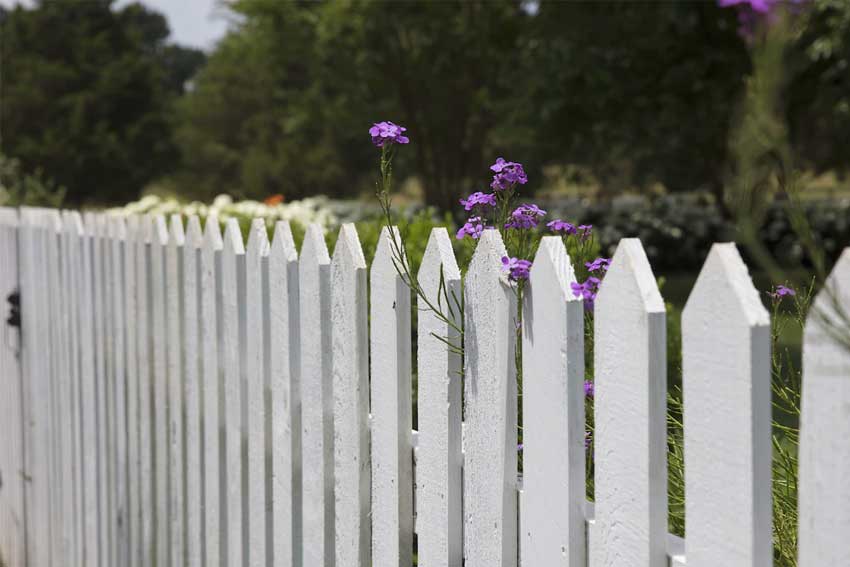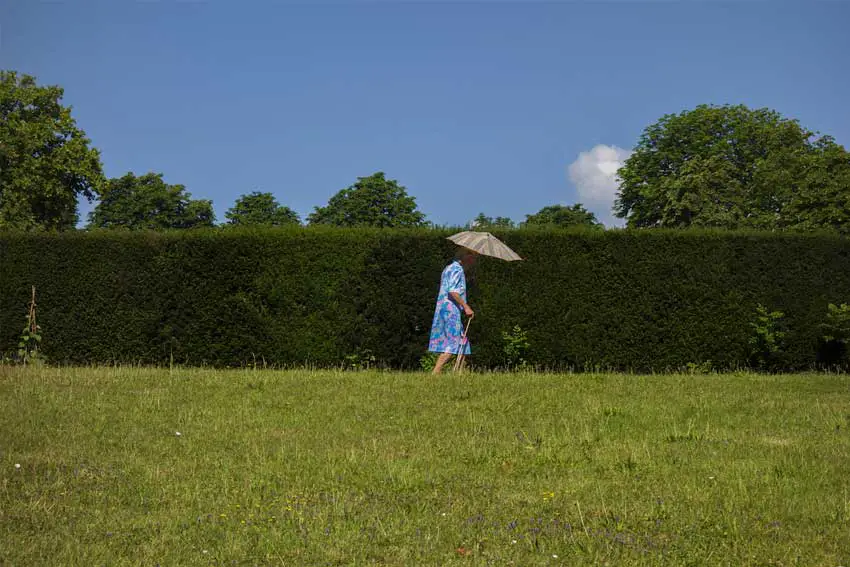Like any fencing, a garden barrier is one kind of fencing to protect the herbs, plants, and other elements of the garden from harmful things like dogs. It also adds aesthetics to your garden. So, every gardener wants to build good garden fencing or edging to surround the garden properly.
But there are variations in garden edging or barriers depending upon their sizes, materials, types, etc. And it also varies for which you are adding garden fencing or landscape edging there. Here we’re going to discuss different types of garden barriers that are used for dissimilar purposes. Let’s begin.
What is Garden Barrier?

A garden barrier is an outside enclosure to the garden. It surrounds and protects the garden from invading animals and harmful things. Garden barrier is also called garden edging, garden border, garden fencing, landscape edging, etc.
The main component of garden edging is posts and connected materials like wires, nets, rails, boards, and many more. A garden border is different from a wall as the wall has a solid foundation, but the barrier mightn’t be necessarily solid always.
Advantages of Garden Barrier
Why do you need a garden barrier? Landscape edging is worked as a restriction to enter unwanted animals and insects there. But there are many other reasons why garden barriers are used such as-
- Protects the garden from entering animals and insects
- Extends aesthetics
- Prevents soil erosion and preserves soil structure
- Improves drainage
- Reduces soil compaction that improves aeration, rooting
- Lowers garden maintenance costs
Are There Any Disadvantages of Having A Garden Barrier?
Although the garden barrier provides lots of benefits, still there are some minor disadvantages such as-
- Limit visibility: Higher barriers may limit your viewing. So, you might fail to see what’s happening in the whole garden.
- Obstruct friends to enter: Garden barriers not only hinder harmful things to enter the garden but also obstruct the good things too.
- Stagnant water: Sometimes water may be piled up in the garden due to edging or barriers that could harm the plants.
Garden Barrier/Border Ideas
Different garden barriers are used for dissimilar purposes. You can buy ready-made garden borders at cheap and expensive prices or make DIY garden fencing. Here are some of the popular garden border ideas-
Garden Barrier for Dogs

Dogs might spoil your garden plants thus you never allow them in the garden even the pet dog, right? So, a dog-proof fence is essential, especially in the growing vegetable season. This is not only for protecting vegetables but also for considering the good health of the dogs as not all vegetables are safe for dogs.
Usually, the 24-inch barrier between fence and soil is well for small dogs but you can consider 30 to 36 inches fencing for active and large dogs. You can use various types of fencing to keep dogs away such as wooden lattice panels, wire mesh fencing, poultry netting, framed trellis panels, etc.
Garden Barrier for Rabbits
Rabbits love to nibble veggies, especially carrots. So, you mightn’t like to see this thus garden edging for rabbits is necessary. As rabbits can’t climb or jump too high so no need to worry about fence height you may use 2 feet high fence here.
Chicken wire fences work best to make rabbit-proof borders. You can create a 1-inch or smaller size mesh chicken wire fence to keep rabbits out. But rabbits are diggers so you need to dig down a little such as you can put a chicken net at least 6 inches below the ground.
Moreover, if you see any nibble in mesh then you can use enforcer motion-activated sprinklers to surprise and send them running. You can use an electrified fence or dig a trench too to stop rabbits from entering the garden.
Garden Barrier for Pet Animals
If you have pet animals like cats, dogs, rabbits, and so on they might visit the garden and could harm the plants and vegetables. So, what’s the common garden fence for all pet animals?
Well, a chicken wire border will be the most suitable option if you have multiple pets at home. But you can use split-rail, closed-board, picket, chain link, or metal fencing too.
Garden Barrier for Birds
Like other animals, some birds might harm the garden plants and fruits. Bird netting, chicken wire cloche, crop cages, etc, are some of the great garden border ideas to keep birds out of the garden.
Sound Barrier for Garden

Excessive noise has some negative effects on the body and mind. So, you might want to make a soundproof garden or look for a way to reduce the noise at least, right? Before blocking sound, it’s important to consider the source and distance of the sound. And the budget is also an important fact as some soundproofing projects are very expensive.
To reduce sound in the garden you can surround the garden with plant hedges, acoustic fences, mass-loaded vinyl, sound-deadening mats, etc. You can also build a wall or install a shed over the garden to block noise.
But, mass-loaded vinyl and sound-deadening mats are very effective but quite expensive soundproofing systems. Keep in mind, that if the noise source is closer to you, then it’ll be quite harder to block sound effectively.
Wind Barrier for Garden
Heavy winds may harm the garden plants or could fly away the playsets. So, proper wind barriers are essential. You can enclose the garden with hedges or plant trees at garden edges to block gales and gusts.
On the other hand, solid walls of wood or metal are good options to protect the garden from strong winds. You can also make a tunnel house using net cloches and keep the plants and vegetables to protect them against the wind.
Water Barrier for Garden
Excessive water might be a potential threat to plants and vegetables. If you live in an area where the overflow of drain water, stagnant water, or flood is very often, you should install a water barrier to protect the garden herbs and plants. The height of the barrier depends on the garden and water situation.
You can build a small height concrete wall to protect the garden from water damage. The sandbag method is another effective way to solve the problem. To do it fill the sandbags with sand, soil, etc, and keep them around the garden borders. If rains, you can make shade there.
Alternatively, you can make a raised garden bed for a water-proof garden. For a temporary and cheap solution, you can sink polyethylene below the ground at 1 to 2 feet height above and then surround the garden. But for a permanent solution, it’s important to improve the drainage system of the garden for water prevention.
Moisture Barrier for Garden
Sometimes moisture may be harmful to the garden plants. In this case, moisture prevention is important. If you want to make a moisture-proof garden, a greenhouse or tunnel will be an ideal solution. After making the tunnel, surround it with plastic or polypropylene including shed.
Insect Barrier for Garden
Pests invasion might happen to the garden during the growing season. To protect your garden plants from insects, you need proper fencing, right? Installing fine mesh holes in insect netting is the best way to make the garden insect-proof. This netting allows sun rays and airflow but prevents pests.
Pest netting is available in fine and ultra-fine netting. Depending upon the insect type, you have to choose the right one. Like insect netting, butterfly netting keeps butterflies out.
Snail Barrier for Garden
Snail is a potential threat to the garden as some of them chew the tender leaves of your garden plants. So, the snail barrier is crucial. Copper wire, Vaseline, mechanic slug fence, electric slug fence, protective plant cover, and more are some of the effective ways to repel garden snails and slugs.
Garden Barrier from Big Animals (Special Barriers in Special Circumstances)

If you live in an area where deer, bears, and other big animals are seen frequently so there is a high chance that these animals may visit your garden. But, you mightn’t prefer these unwanted visits. So, the garden should be protected from these animals.
Deer netting is a perfect way to keep big animals out of the garden. Be sure, it’s more than 8 feet tall so deer can’t jump over it. If the net is invisible, that will be great too. You can use an electric fence for bears.
Most Common Types of Material Used for Garden Barrier or Landscape Edging
Now we’ll discuss different commonly used garden barriers depending upon the material.
Weed Barrier for Garden
Garden weed barriers comprise geotextile materials like polypropylene or polyester. Usually, they are covered by mulch for aesthetics as well as for preventing the degradation of the fabric due to the sun and harsh weather. Fabric weed barriers reduce weed infiltration but allow oxygen, water, and fertilizer to reach the plant.
The weed barrier is much more effective to control invasive weeds than the chemical, organic mulch, or cultivation method. They are available in small to large sizes that allow choosing your required size for the garden.
Metal Barrier for Garden
Metal landscape edging is great to preserve the soil structure. This works as a staple in the garden to keep curvaceous materials. It’s strong and long-lasting that lasts more than 20 years, that’s impressive. Another good thing about a metal garden border is that it’s flexible thus you can easily shape it according to your landscape design like straight, curves, angles, or any other complex shapes.
Steel and aluminum metals are used mainly as landscape edging. Several types of steel metals are used as metal barriers in the garden including galvanized steel, wrought Iron, zam steel, corten steel, etc. It cost around $2.50 to $6.50 per unit foot on average and the exact value depends on edging thickness.
Wood Barrier for Garden

Wooden fencing is aesthetically pleasing. Timber borders are used for versatile purposes like raised bed edging, garden barriers, etc. You can either buy a pre-made wooden fence or make it at home. Depending upon material quality the cost may vary.
Timbers don’t bend or dip and last longer. Moreover, you can apply pressure treatment on it to make it more durable. Landscape timbers come in different shapes like fence posts, square-edged, round, oval, flat, and a few more. You can paint it to get the desired color.
Plastic Barrier for Garden
The plastic barrier is another important type of material for the garden barrier. There are two types of plastic barriers like woven plastic barriers and solid plastic barriers. The first type prevents weed to grow but allows water to permeate through but the second one blocks both water and weed.
They are made of PVC, polyethylene, etc. They’re quite affordable and lightweight. You can use them for edging your raised garden bed or as a ground cover for weed and moisture prevention.
Stone Barrier for Garden
Stone provides one of the best aesthetically pleasing borders to the garden. You can stone in the garden landscape in different ways. You can use it for lawn edging, flower bed edging, stone retaining walls, brick, and block edging, etc. Gravel is a good item to use for garden edging.
The stone barrier is a modern and solid layout garden border. You can use stone for straight, curved, or corner landscape edging. Paver stone and flagstone are widely used for lawn edging. And the natural stone is always welcome for a captivating outlook.
Concrete Barrier for Garden
Concrete edging provides permanent landscape edging to your garden. Maybe you’re tired to replace the broken or rusted cheap metal or plastic, right? Don’t worry, the concrete garden barrier will be a long-term solution for you. To get a captivating look, hire a professional and do it.
Not only the aesthetics but also concrete edging is a practical way to prevent weeds in your garden. Cheap to expensive, different concrete garden barriers are available. And you can color the concrete landscape edging to match your garden landscape design.
Fabric/Cloth Barrier for Garden
If you’re looking for a good weed control method, landscape fabric or cloth will be a great way. It prevents sprouting of the weeds from the ground. This is also an effective solution to stop soil erosion. Cloth barriers come in at least 3 ft wide and 50 to 200 ft long.
This garden cloth barrier is a natural alternative to chemical herbicides. The pins of this fabric are easy to put on the ground. Some gardeners use a mulch to cover the fabric landscape for good aesthetics.
Brick Barrier for Garden
The brick barrier provides a clear boundary between the garden and grass. By doing this, you can add a charming look to your garden border. As almost all of us are familiar with a brick foundation, so everyone can do it easily.
Brick is also quite inexpensive, last longer, and needs less maintenance. Although this requires some soil work, still considering the overall good sides it is worth the investment.
Rubber Barrier for Garden
Rubber garden edging is an incredible way to make gardens and flowerbeds. It is malleable in nature and thus can be found in several shapes. Rubber also lasts longer but not as lengthy as metal. You can buy rubber mulch in different colors, shapes, and sizes.
Rubber barrier comes in different types such as rubber curb, crump, roman stone, decorative edging, and so on. It is made from recycled material and quite expensive.
Rope Barrier for Garden
A garden rope barrier is a classical method to build fences around the garden. To do this, you need posts and ropes. The rope should be durable enough. Nylon rope is very strong to use as a garden barrier. Depending upon the rope barrier’s purpose, the fence’s height will be low or high.
Paper Barrier for Garden
If you look for lightweight, cheap fence edging for the garden, paper landscape edging will be an ideal option. This includes cardboard and other papers. It’s natural and biodegradable that is made from recycled paper. This will be an alternative to plastic or fabric weed barriers. You can also use it in raised garden beds.
Tips on Garden Barrier/Border/Edging/Fence
- The right garden fencing/edging depends on garden size, soil type, plants, etc.
- Choose the right material for garden borders/landscape edging, but consider your budget too.
- If it’s the fence, make sure it can keep animals out. And for edging consider aesthetics.
- Keep an eye out to know when fencing/edging needs repair.
Garden Barrier FAQs
How do you build a garden barrier?
The main steps for making garden barriers are- measuring the garden and determining which fencing will suit here best, preparing the essentials like posts, netting, or ropes, and then installing the posts and other things on garden borders.
What type of garden edging is best?
This largely depends on your garden. In general, rubber, aluminum, and metal are some of the best materials for garden borders.
Is plastic garden edging any good?
Plastic edging is a lightweight and affordable option. But it’s not so durable as metal edging.
How deep should a garden border be?
This varies with the border length and the protection type that you’re looking for. Longer borders should be 3 to 4 ft deeper whereas super longer borders should be doubled than the first one.
What is the easiest edging to install?
No-dig edging is considered the easiest edging to install without much effort. But it needs stakes to secure in the ground.
What is the best lawn edging to buy?
Steel or aluminum is the best choice for lawn edging. It can be installed using stakes and allows it to be molded into curves or shapes. It won’t rot, rust, or become brittle.
Where to buy garden barriers?
Garden barriers are available either online or brick and mortar shops. Amazon, eBay, Walmart, and Homedepot are some of the reliable options.
How do you keep grass from growing over edging?
You can dig narrow trenches between the lawn and the edging. This soil-free space will help greatly to prevent grass from growing over the garden edging.
How do you put a border on a small garden?
You can put landscape edging materials like rubber, stone, metal, etc, to separate one portion from another. And consider the pathway too.
How do you design a garden border?
This includes different things like considering soil type, garden shape, and size, choosing the best plants, picking the right theme, building a pattern, and so on.
How do you anchor landscape edging?
Firstly, choose the right anchors for your landscape edging. Anchors might be made from plastic, metal, wood, etc. After placing the landscape edging in the borders of the garden, insert the anchors in the ground to tie down the edging rightly. Some anchors are directly driven over the edging but another type needs extra straps to tie the anchors and edging together for better anchoring.
How do I make my garden borders look good?
The garden border or edging itself looks good. Moreover, you can add some items for making it more elegant like adding bulbs, painting the borders, planting flower plants on the garden edges, etc.
Do you need stakes for garden barriers?
Yes, stakes are used to hold the lightweight garden barrier (like fabric, plastic, and paper) in place. Plastic, bamboo, wood, and metal stakes are widely used for fence edging.
Conclusion
A garden without a barrier or border is just like a painting without a frame. So, a garden barrier or edging brings amazing aesthetics to the garden. This article describes different garden border ideas like wood barriers, weed barriers, fabric edging, barriers for dogs and rabbits, concrete edging, and many more.
Now, build the best fencing around the garden to protect the plants and improve the impression of the garden.
A video on garden edging:

I’m Shofi, a passionate gardener and blogger. I have 10+ years of experience in gardening and hold certifications in horticulture and garden design. I share my knowledge and skills through my garden blog to inspire and educate others on the joys of gardening. I try to provide valuable information and create a community for gardeners of all levels to connect and learn. My ultimate goal is to inspire others to start their own gardens and connect with nature.
